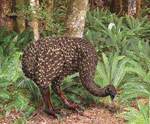Extinct moa rewrites New Zealand's history
 Ancient DNA Ancient DNA
DNA recovered from fossilised bones of the moa, a giant extinct bird, has revealed a new geological history of New Zealand. A team of scientists led by the University of Adelaide has reconstructed a history of marine barriers, mountain building and glacial cycles in New Zealand over millions of years, using the first complete genetic history of the moa. After almost being totally submerged around 25 million years ago, the current South and North Islands were separated by a large sea until around 1.5 million years ago, researchers said. Project leader Professor Alan Cooper, from the University of Adelaide's Australian Centre for Ancient DNA (ACAD), said New Zealand was recognised as one of the world's "great evolutionary laboratories" due to the absence of land mammals and the radiation of giant flightless birds such as the moa. "Yet this research is rewriting the geological history of New Zealand and shows how little we really know about it," Professor Cooper said. The team of Australian and New Zealand researchers sequenced DNA from hundreds of birds collected from caves and swamps, including all nine species of moa. The birds, which weighed up to 250kg, were the dominant animals in New Zealand's pre-human environment but were quickly exterminated after the arrival of the Maori around 1280 AD. "We found that the remarkable evolutionary dispersion of the nine moa species took place in only seven million years and seems to have occurred as the Southern Alps rapidly rose up and created lots of new habitats," Professor Cooper said. The evidence also suggested that many of New Zealand's iconic species - including the kiwi, tuatara and kauri - evolved solely on the South Island. "This raises the question of what was happening on the North Island during this time," Professor Cooper said. Lead author Dr Mike Bunce from Murdoch University extracted traces of DNA from moa bones, mummies and coprolites, which the researchers were able to use to create the first detailed evolutionary time frame for moa. Professor Peter Kamp from Waikato University led the geological mapping that revealed the extent of the seaway separating the two islands, as well as the uplift history of the Southern Alps. "When the seaway was first bridged by land around 1.5 million years ago, it is likely that a major interchange of species took place as also occurred between North and South America across the Panama isthmus around three million years ago," Professor Kamp said. Team member Dr Trevor Worthy from the University of NSW said the study was "an excellent example of how museum specimens can contribute to cutting-edge science". The study has been published in the Proceedings of the National Academy of Sciences. Story by Candy Gibson
|





